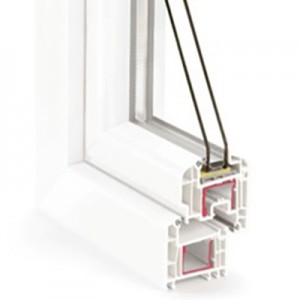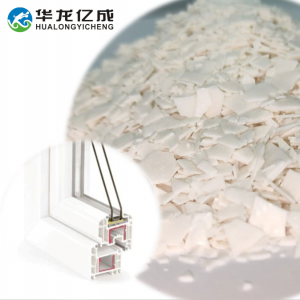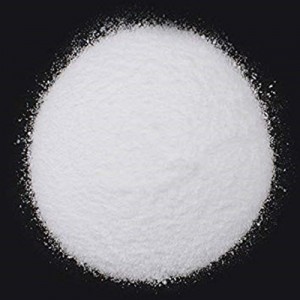Before PVC can be made into products, it has to be combined with a range of special additives. These additives can influence or determine a number of the products properties, namely; its mechanical properties, weather fastness, its colour and clarity and indeed whether it is to be used in a flexible application. This process is called compounding. PVC's compatibility with many different kinds of additives is one of the materials many strengths and is what makes it such a highly versatile polymer. PVC can be plasticised to make it flexible for use in flooring and medical products. Rigid PVC, also known as PVC-U (The U stands for "unplasticised") is used extensively in building applications such as window frames.
The functional additives used in all PVC materials include heat stabilisers, lubricants, and in the case of flexible PVC, plasticisers. Optional additives, include a range of substances from processing aids, impact modifiers, thermal modifiers, UV stabilisers, flame retardants, mineral fillers, pigments, to biocides, and blowing agents for specific applications. The actual PVC polymer content in some flooring applications can be as low as 25% by mass, the remainder accounted for by additives. Its compatibility with additives allows for the possible addition of flame retardants although PVC is intrinsically fire retardant because of the presence of chlorine in the polymer matrix.
Functional Additives
Heat stabilisers
Heat stabilisers are necessary in all PVC formulations to prevent the decomposition of the PVC by heat and shear during processing. They can also enhance the PVC's resistance to daylight, and to weathering and heat ageing. In addition heat stabilisers have an important influence on the physical properties of the PVC and the cost of the formulation. The choice of heat stabiliser depends on a number of factors including the technical requirements of the PVC product, regulatory approval requirements and cost.
Lubricants These are used to reduce friction during processing. External lubricants can reduce friction between the PVC and the processing equipment, whereas internal lubricants work on the PVC granules.
Plasticisers A plasticiser is a substance which when added to a material, usually a plastic, makes it flexible, resilient and easier to handle. Early examples of plasticisers include water to soften clay and oils to plasticise pitch for waterproofing ancient boats. The selection of plasticisers depends on the final properties required by the final product, and indeed whether the product is for a flooring application or a medical application. There are more than 300 different types of plasticisers of which about 50-100 are in commercial use. The most commonly used plasticisers are phthalates which can be divided into two distinct groups with very different applications and classifications; Low Phthalates: Low molecular weight (LMW) phthalates contain eight or less carbon atoms in their chemical backbone. These include, DEHP, DBP, DIBP and BBP. The use of these phthalates in Europe is limited to certain specialised applications. High Phthalates: High molecular weight (HMW) phthalates are those with 7 - 13 carbon atoms in their chemical backbone. These include: DINP, DIDP, DPHP, DIUP and DTDP. HMW phthalates are safely used in many everyday including cables and flooring. Speciality plasticisers, such as adipates, citrates, benzoates and trimeliltates are used where special physical properties are required such as the ability to withstand very low temperatures or where increased flexibility is important. Many of the PVC products we use everyday but tend to take for granted contain phthalate plasticisers. They include everything from lifesaving medical devices such as medical tubing and blood bags, to footwear, electrical cables, packaging, stationery, and toys. In addition, phthalates are used in other non-PVC applications such as paints, rubber products, adhesives and some cosmetics.
Optional Additives
These optional additives are not strictly necessary for the integrity of the plastic but are used to draw-upon other properties. Optional additives include processing aids, impact modifiers, fillers, nitrile rubbers, pigments and colorants and Flame Retardants.
Post time: Jan-20-2025




